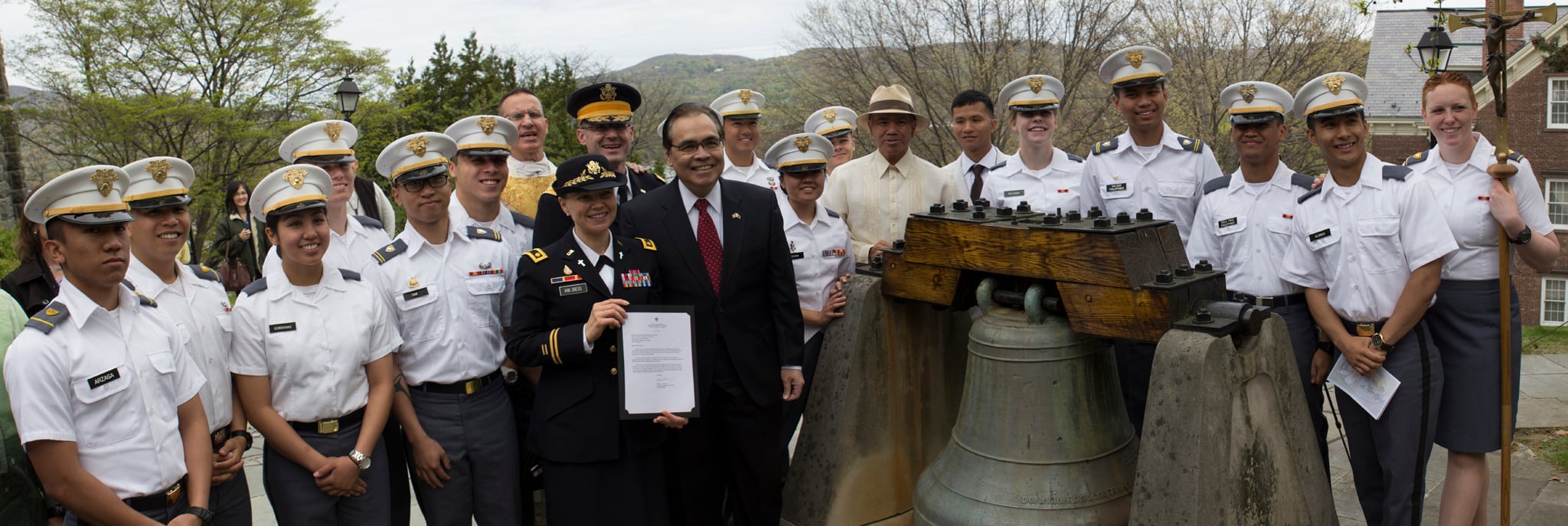The San Pedro bell, stationed outside West Point's Most Holy Trinity Catholic Chapel since the 1980s, will be shipped to the Church of Saint Peter and Paul in Bauang, Philippines, where it was taken by U.S. forces during the Philippine-American War at the turn of the 20th century. Academy officials, Filipino-American students and members of the U.S.-Philippine Society, among others, were on hand for an April 29 ceremony marking the turnover.
The bell became property of the academy in 1915 and was lost for a time before its rediscovery during chapel expansion in 1959.
In the intervening decades, other bells with similar war stories have been returned to their owners. One example: Naval Academy officials rang the Gokoku-ji bell, taken by Commodore Matthew Perry from Okinawa in 1853, as part of celebrations after Army-Navy football victories. It was returned in 1987; a replica has been used since.
The West Point bell's history came to light thanks in part to retired Navy Rear Adm. Dan McKinnon, whose interest in Philippine history dates back to his service in the region. He worked to preserve Clark Veterans Cemetery, about 60 miles north of Manila, which had been coated in ash from a 1991 volcanic eruption and left mostly unkept until a 2013 memorandum of understanding allowed a U.S. agency to care for the grounds.

West Point cadets and dignitaries bid farewell to the San Pedro bell, which has been property of the U.S. Military Academy for 101 years and is on its way back to the Philippines.
Photo Credit: Thomas B. Hamilton III/Army
"We started researching all this stuff, and then somebody said, 'Well, there's a bell like these sitting at West Point,' " McKinnon said. "So about a year ago, I started talking to West Point. … The people at West Point told me where the bell had come from."
McKinnon's friend and fellow former Navy man, Dennis Wright, led research efforts in the Philippines to track down the church where the bell once rang. Eventually, Father Ronald Chan of the Church of Saint Peter and Paul wrote a letter to Lt. Gen. Robert Caslen, West Point's superintendent, citing the return of similar war trophies and requesting the same of the academy.
"It is the right and honorable thing to do," he wrote. "We sincerely hope and pray that you will honor our request and allow us the opportunity to once again hear the call of San Pedro to our church services."
Unlike the Wyoming-based bells, there was no controversy.
"The superintendent said, 'Sure, this is a no-brainer. Bells belong in churches,' " McKinnon said.
The bell likely was removed from the church by U.S. troops to prevent enemy forces from melting the gold-silver-copper alloy down to make weapons, McKinnon said. General Order No. 100, also known as the Lieber Code, prohibited U.S. forces from removing such items as spoils of war, he said, but the order was often misinterpreted or ignored.
"Technically, all three of these bells [in Wyoming and at West Point] should've gone home in 1902, when the war was over, but nobody paid attention to this kind of stuff," he said.
Kevin Lilley is the features editor of Military Times.




